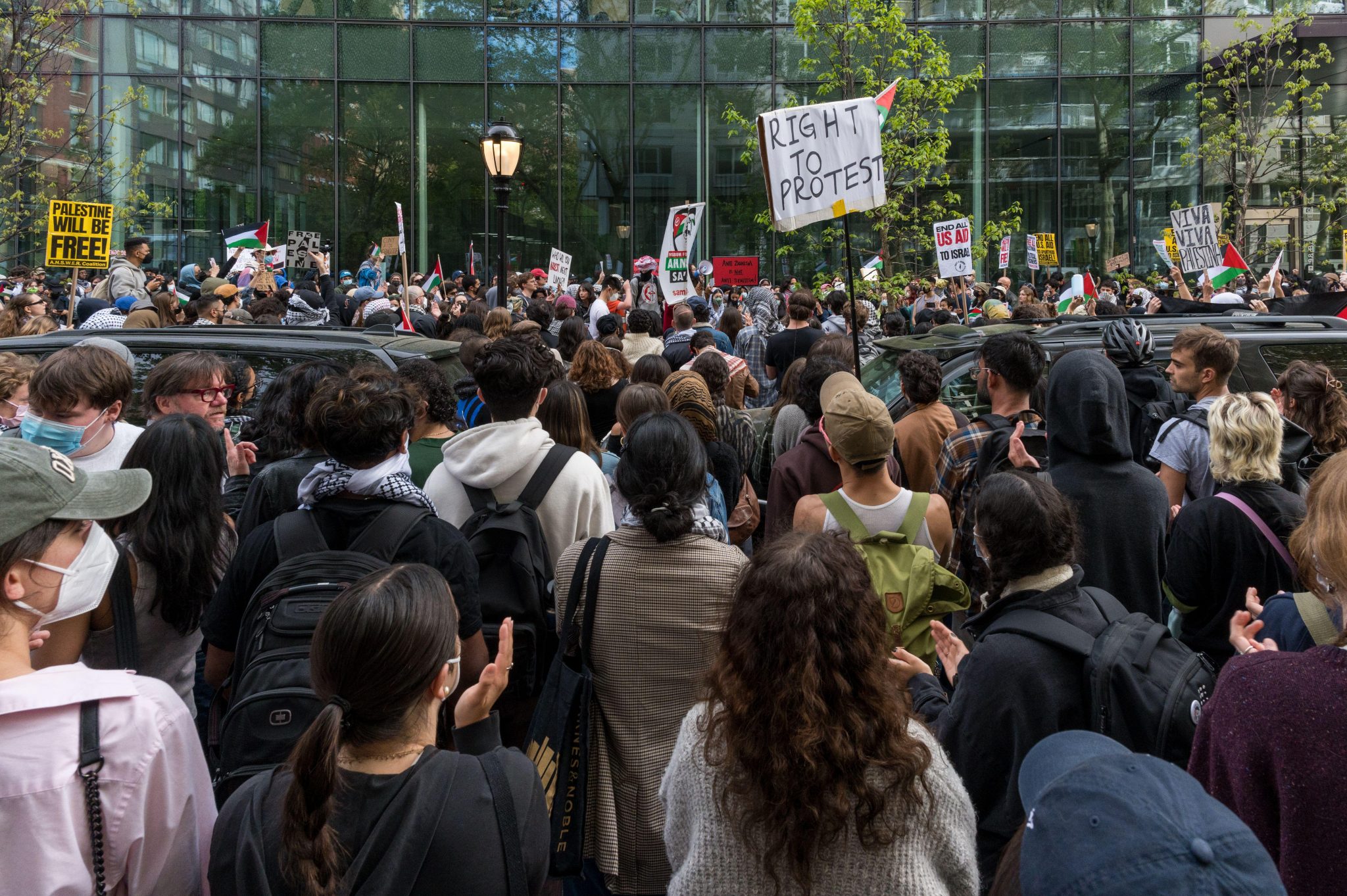The recent protests at college campuses across the US strike at the very heart of the existential struggle over the meaning of the university
In the past three weeks, roughly one hundred encampments have cropped up on American campuses in protest of Israel’s US-backed war in Gaza. The university occupations span from coast to coast, from the Ivy League to state schools, from small liberal arts schools to community colleges. Over a thousand protesters have been arrested since the campus actions began on 18 April. It’s the largest US student revolt since the late 1960s and early 70s, when campuses were aflame with protest over the Vietnam War.
Speaking to a large crowd at Harvard’s encampment on Monday, a student activist summarised the movement’s strategy, saying, “If these universities only care about their assets, the student movement will become a liability.” The assets in question are considerable: Harvard is the wealthiest university in the world, with an endowment of $50.9 billion. In Harvard Yard, protesters decorated a baronial statue with a makeshift missile, the words ‘Paid for By Harvard’ scrawled in school-spirit crimson. As on most campuses, protesters at Harvard are demanding their university disclose and discontinue investments in the US war machine and Israeli industry, hoping to exert economic leverage against the assault on Gaza.
For the last decade American universities have been reliable hotbeds of protest, from the #MeToo movement to Black Lives Matter. But while campus community members wrestle over issues like sexual assault and racial prejudice, institutional finances often evade full scrutiny. Administrations tend to keep their investments private and exploit the complexity of finance to prevent further interrogation. For many in the campus community, university endowments and investments are a black box: vast and powerful but impenetrable and unaccountable. The financial heart of the institution remains hidden from view, even as it pumps resources into priorities that may not align with the university’s stated mission.
In an echo of earlier struggles against war in Vietnam and apartheid in South Africa, student activists today are training their sights directly on university investments. In so doing, they’re not only acting strategically to end the war in Gaza but also striking at the very heart of the existential struggle over the meaning of the university.

In recent decades universities have undergone a rapid, institution-rotting mission creep. The university has always occupied multiple contradictory roles in society, and we can dispense with any idealised past. Nevertheless, it’s evident that its role as a site of knowledge cultivation has given way to its new incarnation as an economic machine that operates in the interests of high-paid university administrators, wealthy donors, financial managers, private equity firms and investment banks, and the corporations that university funds are invested in. This corporatisation of the university can be felt on every campus, whether elite or trade-oriented, public or private.
In the US, diminished public funding since the early 2000s has held both public and private universities’ feet to the financial fire. They’ve responded by embracing a chipper but merciless ethos of streamlining and belt-tightening borrowed from the corporate world. Austerity-minded universities are reluctant to tap into their own reserves, preferring instead to transfer financial risks and burdens to students and faculty.

Administrations have thinned the number of professors per student, replacing them with a ballooning class of administrators. They shutter departments while adding cubicles, a fluorescent-lit reflection of the business-oriented turn in university management. They shunt remaining faculty into precarious positions and increasingly allocate research and instruction to dramatically underpaid graduate students. They continue hiking tuition for low-income students to cover budget shortfalls, initiating students into a lifetime of debt. When a university does dig into its pockets, it’s likely to invest in real estate expansion, wasteful private contracts or splashy new facilities designed to boost its image, rather than in higher pay and better financial aid packages.
All the while, university financial assets, endowments and private-sector partnerships remain untouchable. Academic workers and students suffer while assets multiply, vibrating with untapped potential. Institutional resources are earmarked for aggressive investing, not solving campus-level problems. As higher education scholar Christopher Newfield argues, endowments became a growth priority to mitigate the dramatic fall in public funding. However necessary that may have been, a new culture of corporate wealth management has since taken root among university leadership. The result is an increase on ‘the dependence of continued quality on private wealth, narrow investment, sharp stratification, costly competition and the concentration of resources at the top’.

By focusing on university investments in US weapons manufacturers and Israeli industry, student activists are putting their finger on the profound and urgent question facing higher education: what are universities for? Are they fundamentally social or antisocial? Do they serve themselves or the ‘greater good’?
If universities are essentially corporations – which exist for the sole purpose of making money – then it’s consistent with their role in society for them to invest in whatever’s most lucrative, even if that means funneling money into Israeli surveillance technology firms and American bomb manufacturers. But if universities exist instead to promote general flourishing by fostering the exchange and transmission of knowledge, then they’re contravening their public mission by investing in lucrative vehicles of violence and destruction. For higher education, some soul-searching is clearly in order.
Today’s laser focus on universities’ financial activities is notable, but it hasn’t arrived entirely out of the blue. In addition to drawing on many years of activism in solidarity with Palestine, it builds on the successes of divestment-focused climate activists, which have compelled administrations to opt for environmental, social and governance (ESG)-compliant investment portfolios that align with their values. The current upsurge also follows closely on the heels of the biggest higher education strike in US history, which leveled a strong critique of the neoliberal turn in higher education.
Today’s student activists are not content to focus on ground-level campus issues while institutional finances hover just out of frame. Students are demanding to know where the money goes, and refusing to implicitly cosign financial involvement in ethnic cleansing. They want the university to fulfill its rightful role as a social institution, and they won’t be placated with clichés about economic responsibility and efficiency.
Meagan Day is an associate editor at Jacobin and a writer whose work has been published in the New York Times, the Guardian and the New Republic
